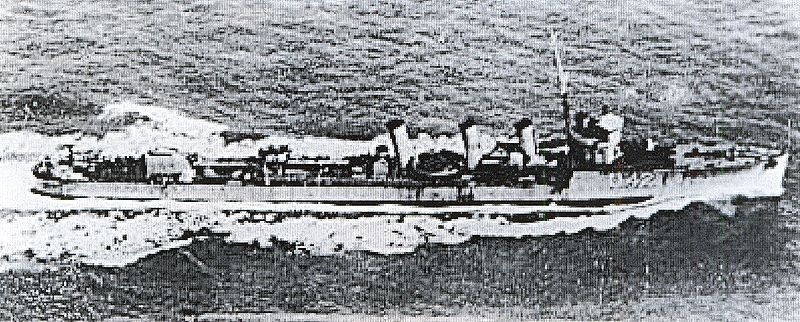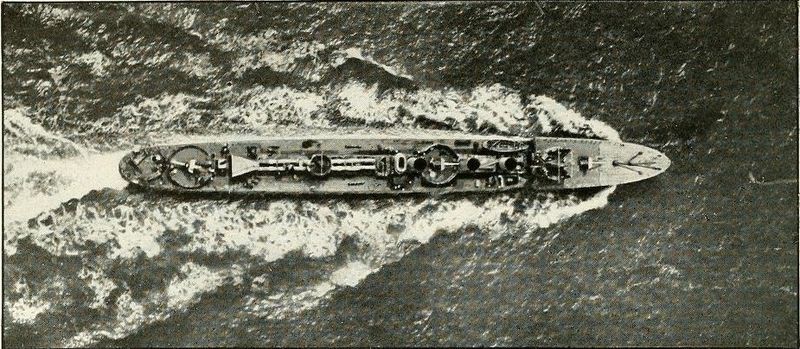Emergency War Construction Programme
At the outbreak of war, the Admiralty decided to submit an emergency shipbuilding programme on a specific design, hence the “Admiralty” denomination, largely based on the previous prewar class L. This was, in fact, a “superclass” counting several sub-classes:
-Six prewar “M” ships (which were lighter at 1010 tons and smaller) built at Palmers, Swan Hunter and John Brown;
-Sixteen “M” ordered in September 1914 (John Brown, Thornycroft, White, Fairfield, Swan Hunter)
-Nine other in November (some with “N” names) (same)
-Twenty-two late November (“N” and “O” names) (same)
-Sixteen February 1915 (“N”, “O” an “P” names) (same, but they had raking stems)
-Sixteen in May 1915 (“M” and “P” names) (same, but raking stems)
⚠ Note: This post is in writing. Completion expected in late 2023.
❯❯❯❯❯❯❯❯❯❯❯
Characteristics
They were all largely based on preceding L class, all ships had three identical narrow circular funnels, a raised forecastle, three QF 4 in (102 mm) Mark IV guns, on mounting P Mk.IX, one forward, two aft, with the “Y” gun raised on a superstructure, and two twin banks of 21 in (533 mm) torpedo tubes. Anti-aircraft artillery was also present with two individual QF 2-pounder Bofors “pom-pom” Mk.II. Displacement was about 1000 tonnes (994 light, 1010 standard, 1059 fully loaded). These were propelled by three shafts in direct drive with steam turbines, 25,000 shp (18,642 kW)
which have a top speed of 34 knots (39.1 mph; 63.0 km/h). These were sturdy ships fit for the North Atlantic and North Sea, with a sufficient range due to their 237–298 tons fuel oil carried. The pre-war sub-group only had cruising turbines, the idea was dropped for mass-production. Another difference was the second 4 inch-gun was mounted on a bandstand.
Active service
All these ships were quite active during the war. HMS Marmion (1917), HMS Negro (1916), HMS Nessus (1918), HMS Narborough (1918), Narwhal (1916) were lost by collision with other ships or reefs, HMS Mary Rose by cruiser SMS Brummer and SMS Bremse off the Norwegian coast, the HMS Partridge by German destroyers in December 1917, the HMS North Star at Zeebrugge in 1918, HMS Pheasant (mine, 1917 off the Orkney Islands) and more famously the HMS Nestor and Nomad were sunk at the battle of Jutland. The remainder sold for scrap in 1921. During the war, Partridge, Norman, Maenad, Ophelia and Observer all received equipment to operate a kite balloon.
Links
M-Class destroyers on wikipedia
ww1 British Destroyers on navypedia
Specs Conway’s all the world fighting ships 1921-1947.
M-class (1915 specifications) |
|
| Dimensions | 82 x8,4 x3,2m (269 x27x 10ft) |
| Displacement | 994t, 1042t FL |
| Crew | 80 |
| Propulsion | 3 shafts, steam turbines, 25,000 shp (18,642 kW) |
| Speed | 34 knots (39.1 mph; 63.0 km/h) |
| Armament | 3 x102 mm Mark-IV QF, 2 x40 mm AA, 2 x2 533mm TT (axial). |
Gallery

1/750 Profile of a M-class torpedo-boat destroyer.



.jpg)
.jpg)

.jpg)
.jpg)
 Latest Facebook Entry -
Latest Facebook Entry -  X(Tweeter) Naval Encyclopedia's deck archive
X(Tweeter) Naval Encyclopedia's deck archive Instagram (@navalencyc)
Instagram (@navalencyc)





 French Navy
French Navy Royal Navy
Royal Navy Russian Navy
Russian Navy Armada Espanola
Armada Espanola Austrian Navy
Austrian Navy K.u.K. Kriegsmarine
K.u.K. Kriegsmarine Dansk Marine
Dansk Marine Nautiko Hellenon
Nautiko Hellenon Koninklije Marine 1870
Koninklije Marine 1870 Marinha do Brasil
Marinha do Brasil Osmanlı Donanması
Osmanlı Donanması Marina Do Peru
Marina Do Peru Marinha do Portugal
Marinha do Portugal Regia Marina 1870
Regia Marina 1870 Nihhon Kaigun 1870
Nihhon Kaigun 1870 Preußische Marine 1870
Preußische Marine 1870 Russkiy Flot 1870
Russkiy Flot 1870 Svenska marinen
Svenska marinen Søværnet
Søværnet Union Navy
Union Navy Confederate Navy
Confederate Navy Armada de Argentina
Armada de Argentina Imperial Chinese Navy
Imperial Chinese Navy Marinha do Portugal
Marinha do Portugal Mexico
Mexico Kaiserliche Marine
Kaiserliche Marine 1898 US Navy
1898 US Navy Sovietskiy Flot
Sovietskiy Flot Royal Canadian Navy
Royal Canadian Navy Royal Australian Navy
Royal Australian Navy RNZN Fleet
RNZN Fleet Chinese Navy 1937
Chinese Navy 1937 Kriegsmarine
Kriegsmarine Chilean Navy
Chilean Navy Danish Navy
Danish Navy Finnish Navy
Finnish Navy Hellenic Navy
Hellenic Navy Polish Navy
Polish Navy Romanian Navy
Romanian Navy Turkish Navy
Turkish Navy Royal Yugoslav Navy
Royal Yugoslav Navy Royal Thai Navy
Royal Thai Navy Minor Navies
Minor Navies Albania
Albania Austria
Austria Belgium
Belgium Columbia
Columbia Costa Rica
Costa Rica Cuba
Cuba Czechoslovakia
Czechoslovakia Dominican Republic
Dominican Republic Haiti
Haiti Hungary
Hungary Honduras
Honduras Estonia
Estonia Iceland
Iceland Eire
Eire Equador
Equador Iran
Iran Iraq
Iraq Latvia
Latvia Liberia
Liberia Lithuania
Lithuania Mandchukuo
Mandchukuo Morocco
Morocco Nicaragua
Nicaragua Persia
Persia San Salvador
San Salvador Sarawak
Sarawak Uruguay
Uruguay Venezuela
Venezuela Zanzibar
Zanzibar Warsaw Pact Navies
Warsaw Pact Navies Bulgaria
Bulgaria Hungary
Hungary

 Bundesmarine
Bundesmarine Dutch Navy
Dutch Navy Hellenic Navy
Hellenic Navy Marina Militare
Marina Militare Yugoslav Navy
Yugoslav Navy Chinese Navy
Chinese Navy Indian Navy
Indian Navy Indonesian Navy
Indonesian Navy JMSDF
JMSDF North Korean Navy
North Korean Navy Pakistani Navy
Pakistani Navy Philippines Navy
Philippines Navy ROKN
ROKN Rep. of Singapore Navy
Rep. of Singapore Navy Taiwanese Navy
Taiwanese Navy IDF Navy
IDF Navy Saudi Navy
Saudi Navy Royal New Zealand Navy
Royal New Zealand Navy Egyptian Navy
Egyptian Navy South African Navy
South African Navy






























 Ukrainian Navy
Ukrainian Navy dbodesign
dbodesign